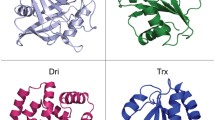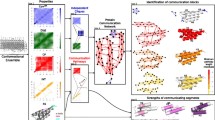Abstract
PyInteraph is a software package designed for the analysis of structural communication from conformational ensembles, such as those derived from in silico simulations, under the formalism of protein structure networks. We demonstrate its usage for the calculation and analysis of intramolecular interaction networks derived from three different types of interactions, as well as with a more general protocol based on distances between centers of mass. We use the xPyder PyMOL plug-in to visualize such networks on the three-dimensional structure of the protein. We showcase our protocol on a molecular dynamics trajectory of the Cyclophilin A wild-type enzyme, a well-studied protein in which different allosteric mechanisms have been investigated.
Access this chapter
Tax calculation will be finalised at checkout
Purchases are for personal use only
Similar content being viewed by others
References
Ribeiro AAST, Ortiz V (2016) A chemical perspective on allostery. Chem Rev 116:6488–6502. https://doi.org/10.1021/acs.chemrev.5b00543
Papaleo E, Saladino G, Lambrughi M, Lindorff-Larsen K, Gervasio FL, Nussinov R (2016) The role of protein loops and linkers in conformational dynamics and allostery. Chem Rev 116:6391–6423. https://doi.org/10.1021/acs.chemrev.5b00623
Guo J, Zhou H-X (2016) Protein allostery and conformational dynamics. Chemical Reviews 116:6503–6515. https://doi.org/10.1021/acs.chemrev.5b00590
del Sol A, Tsai C-J, Ma B, Nussinov R (2009) The origin of allosteric functional modulation: multiple pre-existing pathways. Structure 17:1042–1050. https://doi.org/10.1016/j.str.2009.06.008
Feher VA, Durrant JD, Van Wart AT, Amaro RE (2014) Computational approaches to mapping allosteric pathways. Curr Opin Struct Biol 25:98–103. https://doi.org/10.1016/j.sbi.2014.02.004
Hertig S, Latorraca NR, Dror RO (2016) Revealing atomic-level mechanisms of protein allostery with molecular dynamics simulations. PLoS Comput Biol 12:e1004746. https://doi.org/10.1371/journal.pcbi.1004746
Allain A, Chauvot de Beauchêne I, Langenfeld F, Guarracino Y, Laine E, Tchertanov L (2014) Allosteric pathway identification through network analysis: from molecular dynamics simulations to interactive 2D and 3D graphs. Faraday Discuss 169:303–321. https://doi.org/10.1039/c4fd00024b
Tiberti M, Invernizzi G, Lambrughi M, Inbar Y, Schreiber G, Papaleo E (2014) PyInteraph: a framework for the analysis of interaction networks in structural ensembles of proteins. J Chem Inf Model 54:1537–1551. https://doi.org/10.1021/ci400639r
Bhattacharyya M, Ghosh S, Vishveshwara S (2016) Protein structure and function: looking through the network of side-chain interactions. Curr Protein Pept Sci 17:4–25
Di Paola L, De Ruvo M, Paci P, Santoni D, Giuliani A (2013) Protein contact networks: an emerging paradigm in chemistry. Chem Rev 113:1598–1613. https://doi.org/10.1021/cr3002356
Yan W, Zhou J, Sun M, Chen J, Hu G, Shen B (2014) The construction of an amino acid network for understanding protein structure and function. Amino Acids 46:1419–1439. https://doi.org/10.1007/s00726-014-1710-6
Di Paola L, Giuliani A (2015) Protein contact network topology: a natural language for allostery. Curr Opin Struct Biol 31:43–48. https://doi.org/10.1016/j.sbi.2015.03.001
Hu G, Zhou J, Yan W, Chen J, Shen B (2013) The topology and dynamics of protein complexes: insights from intra- molecular network theory. Curr Protein Pept Sci 14:121–132
Sethi A, Eargle J, Black AA, Luthey-Schulten Z (2009) Dynamical networks in tRNA:protein complexes. Proc Natl Acad Sci U S A 106:6620–6625. https://doi.org/10.1073/pnas.0810961106
Pandini A, Fornili A, Fraternali F, Kleinjung J (2012) Detection of allosteric signal transmission by information-theoretic analysis of protein dynamics. FASEB J 26:868–881. https://doi.org/10.1096/fj.11-190868
Pandini A, Fornili A, Fraternali F, Kleinjung J (2013) GSATools: analysis of allosteric communication and functional local motions using a structural alphabet. Bioinformatics 29:2053–2055. https://doi.org/10.1093/bioinformatics/btt326
Potapov V, Cohen M, Inbar Y, Schreiber G (2010) Protein structure modelling and evaluation based on a 4-distance description of side-chain interactions. BMC Bioinformatics 11:374. https://doi.org/10.1186/1471-2105-11-374
Jónsdóttir LB, Ellertsson BÖ, Invernizzi G, Magnúsdóttir M, Thorbjarnardóttir SH, Papaleo E, Kristjánsson MM (2014) The role of salt bridges on the temperature adaptation of aqualysin I, a thermostable subtilisin-like proteinase. Biochim Biophys Acta 1844:2174–2181. https://doi.org/10.1016/j.bbapap.2014.08.011
Lambrughi M, De Gioia L, Gervasio FL, Lindorff-Larsen K, Nussinov R, Urani C, Bruschi M, Papaleo E (2016) DNA-binding protects p53 from interactions with cofactors involved in transcription-independent functions. Nucleic Acids Res 44:9096–9109. https://doi.org/10.1093/nar/gkw770
Marino V, Scholten A, Koch K-W, Dell'Orco D (2015) Two retinal dystrophy-associated missense mutations in GUCA1A with distinct molecular properties result in a similar aberrant regulation of the retinal guanylate cyclase. Hum Mol Genet 24:6653–6666. https://doi.org/10.1093/hmg/ddv370
Papaleo E, Parravicini F, Grandori R, De Gioia L, Brocca S (2014) Structural investigation of the cold-adapted acylaminoacyl peptidase from Sporosarcina psychrophila by atomistic simulations and biophysical methods. Biochim Biophys Acta 1844:2203–2213. https://doi.org/10.1016/j.bbapap.2014.09.018
Óskarsson KR, Nygaard M, Ellertsson BÖ, Thorbjarnardóttir SH, Papaleo E, Kristjánsson MM (2016) A single mutation Gln142Lys doubles the catalytic activity of VPR, a cold adapted subtilisin-like serine proteinase. Biochim Biophys Acta 1864:1436–1443. https://doi.org/10.1016/j.bbapap.2016.07.003
Nygaard M, Terkelsen T, Vidas Olsen A, Sora V, Salamanca Viloria J, Rizza F, Bergstrand-Poulsen S, Di Marco M, Vistesen M, Tiberti M, Lambrughi M, Jäättelä M, Kallunki T, Papaleo E (2016) The mutational landscape of the oncogenic MZF1 SCAN domain in cancer. Front Mol Biosci 3:78. https://doi.org/10.3389/fmolb.2016.00078
Michetti D, Brandsdal BO, Bon D, Isaksen GV, Tiberti M, Papaleo E (2017) A comparative study of cold- and warm-adapted endonucleases A using sequence analyses and molecular dynamics simulations. PLoS One 12:e0169586. https://doi.org/10.1371/journal.pone.0169586
Salamanca Viloria J, Allega MF, Lambrughi M, Papaleo E (2017) An optimal distance cutoff for contact-based protein structure networks using side-chain centers of mass. Sci Rep 7:2838. https://doi.org/10.1038/s41598-017-01498-6
Marino V, Dell'Orco D (2016) Allosteric communication pathways routed by Ca2+/Mg2+ exchange in GCAP1 selectively switch target regulation modes. Sci Rep 6:517. https://doi.org/10.1038/srep34277
Lambrughi M, Lucchini M, Pignataro M, Sola M, Bortolotti CA (2016) The dynamics of the β-propeller domain in Kelch protein KLHL40 changes upon nemaline myopathy-associated mutation. RSC Adv 6:34043–34054. https://doi.org/10.1039/C6RA06312H
Singh B, Bulusu G, Mitra A (2016) Effects of point mutations on the thermostability of B. subtilis lipase: investigating nonadditivity. J Comput Aided Mol Des 30:899–916. https://doi.org/10.1007/s10822-016-9978-0
Otaki H, Taguchi Y, Nishida N (2018) Molecular dynamics simulation reveals that switchable combinations of β-sheets underlie the prion-like properties of α-synuclein amyloids. https://doi.org/10.1101/326462
Pasi M, Tiberti M, Arrigoni A, Papaleo E (2012) xPyder: a PyMOL plugin to analyze coupled residues and their networks in protein structures. J Chem Inf Model 52:1865–1874. https://doi.org/10.1021/ci300213c
The PyMOL Molecular Graphics System, Version 2.0 Schrödinger, LLC.
Vijayan RSK, Arnold E, Das K (2014) Molecular dynamics study of HIV-1 RT-DNA-nevirapine complexes explains NNRTI inhibition and resistance by connection mutations. Proteins 82:815–829. https://doi.org/10.1002/prot.24460
Hashem S, Tiberti M, Fornili A (2017) Allosteric modulation of cardiac myosin dynamics by omecamtiv mecarbil. PLoS Comput Biol 13:e1005826. https://doi.org/10.1371/journal.pcbi.1005826
Guizado TRC (2014) Analysis of the structure and dynamics of human serum albumin. J Mol Model 20:43. https://doi.org/10.1007/s00894-014-2450-y
Papaleo E, Renzetti G, Invernizzi G, Ásgeirsson B (2013) Dynamics fingerprint and inherent asymmetric flexibility of a cold-adapted homodimeric enzyme. A case study of the vibrio alkaline phosphatase. Biochim Biophys Acta Gen Subj 1830:2970–2980. https://doi.org/10.1016/j.bbagen.2012.12.011
Lambrughi M, Papaleo E, Testa L, Brocca S, De Gioia L, Grandori R (2012) Intramolecular interactions stabilizing compact conformations of the intrinsically disordered kinase-inhibitor domain of Sic1: a molecular dynamics investigation. Front Physiol 3:435. https://doi.org/10.3389/fphys.2012.00435
Invernizzi G, Tiberti M, Lambrughi M, Lindorff-Larsen K, Papaleo E (2014) Communication routes in ARID domains between distal residues in helix 5 and the DNA-binding loops. PLoS Comput Biol 10:e1003744. https://doi.org/10.1371/journal.pcbi.1003744
Invernizzi G, Lambrughi M, Regonesi ME, Tortora P, Papaleo E (2013) The conformational ensemble of the disordered and aggregation-protective 182-291 region of ataxin-3. Biochim Biophys Acta 1830:5236–5247. https://doi.org/10.1016/j.bbagen.2013.07.007
Nigro P, Pompilio G, Capogrossi MC (2013) Cyclophilin A: a key player for human disease. Cell Death Dis 4:e888–e888. https://doi.org/10.1038/cddis.2013.410
Papaleo E, Sutto L, Gervasio FL, Lindorff-Larsen K (2014) Conformational changes and free energies in a proline isomerase. J Chem Theory Comput 10:4169–4174. https://doi.org/10.1021/ct500536r
Schlegel J, Armstrong GS, Redzic JS, Zhang F, Eisenmesser EZ (2009) Characterizing and controlling the inherent dynamics of cyclophilin-A. Protein Sci 18:811–824. https://doi.org/10.1002/pro.89
Holliday MJ, Camilloni C, Armstrong GS, Vendruscolo M, Eisenmesser EZ (2017) Networks of dynamic allostery regulate enzyme function. Structure 25:276–286. https://doi.org/10.1016/j.str.2016.12.003
Doshi U, Holliday MJ, Eisenmesser EZ, Hamelberg D (2016) Dynamical network of residue–residue contacts reveals coupled allosteric effects in recognition, catalysis, and mutation. Proc Natl Acad Sci U S A 113:4735–4740. https://doi.org/10.1073/pnas.1523573113
Rodriguez-Bussey I, Yao X-Q, Shouaib AD, Lopez J, Hamelberg D (2018) Decoding allosteric communication pathways in cyclophilin a with a comparative analysis of perturbed conformational ensembles. J Phys Chem B 122:6528–6535. https://doi.org/10.1021/acs.jpcb.8b03824
Fraser JS, Clarkson MW, Degnan SC, Erion R, Kern D, Alber T (2009) Hidden alternative structures of proline isomerase essential for catalysis. Nature 462:669–673. https://doi.org/10.1038/nature08615
Piana S, Lindorff-Larsen K, Shaw DE (2011) How robust are protein folding simulations with respect to force field parameterization? Biophys J 100:L47–L49. https://doi.org/10.1016/j.bpj.2011.03.051
Jelesarov I, Karshikoff A (2009) Defining the role of salt bridges in protein stability. Methods Mol Biol 490:227–260. https://doi.org/10.1007/978-1-59745-367-7_10
Kumar S, Nussinov R (2002) Close-range electrostatic interactions in proteins. Chembiochem 3:604–617. https://doi.org/10.1002/1439-7633(20020703)3:7<604::AID-CBIC604>3.0.CO;2-X
Eisenmesser EZ, Millet O, Labeikovsky W, Korzhnev DM, Wolf-Watz M, Bosco DA, Skalicky JJ, Kay LE, Kern D (2005) Intrinsic dynamics of an enzyme underlies catalysis. Nature 438:117–121. https://doi.org/10.1038/nature04105
Michaud-Agrawal N, Denning EJ, Woolf TB, Beckstein O (2011) MDAnalysis: a toolkit for the analysis of molecular dynamics simulations. J Comput Chem 32:2319–2327. https://doi.org/10.1002/jcc.21787
Gowers RJ, Linke M, Barnoud J, Reddy TJE, Melo MN, Seyler SL, Dotson DL, Domanski J, Buchoux S, Kenney IM, Beckstein O (2016) MDAnalysis: A Python package for the rapid analysis of molecular dynamics simulations. In: Rostrup S, Benthall S (eds) th Python in science conference. Austin, Texas, pp 102–109
Acknowledgments
The authors would like to thank Elena Papaleo and Emmanuelle Bignon for fruitful comments and suggestions. This work was supported by Carlsberg Foundation Distinguished Fellowship (CF18-0314), The Danish Council for Independent Research, Natural Science, Project 1 (102517), Danmarks Grundforskningsfond (DNRF125) to our group.
Author information
Authors and Affiliations
Editor information
Editors and Affiliations
Rights and permissions
Copyright information
© 2021 Springer Science+Business Media, LLC, part of Springer Nature
About this protocol
Cite this protocol
Lambrughi, M., Sora, V., Tiberti, M. (2021). The PyInteraph Workflow for the Study of Interaction Networks From Protein Structural Ensembles. In: Di Paola, L., Giuliani, A. (eds) Allostery. Methods in Molecular Biology, vol 2253. Humana, New York, NY. https://doi.org/10.1007/978-1-0716-1154-8_10
Download citation
DOI: https://doi.org/10.1007/978-1-0716-1154-8_10
Published:
Publisher Name: Humana, New York, NY
Print ISBN: 978-1-0716-1153-1
Online ISBN: 978-1-0716-1154-8
eBook Packages: Springer Protocols




